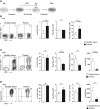Generation of Pure Highly Functional Human Anti-Tumor Specific Cytotoxic T Lymphocytes With Stem Cell-Like Memory Features for Melanoma Immunotherapy
- PMID: 34566953
- PMCID: PMC8456028
- DOI: 10.3389/fimmu.2021.674276
Generation of Pure Highly Functional Human Anti-Tumor Specific Cytotoxic T Lymphocytes With Stem Cell-Like Memory Features for Melanoma Immunotherapy
Abstract
Adoptive immunotherapy based on the transfer of anti-tumor cytotoxic T lymphocytes (CTLs) is a promising strategy to cure cancers. However, rapid expansion of numerous highly functional CTLs with long-lived features remains a challenge. Here, we constructed NIH/3T3 mouse fibroblast-based artificial antigen presenting cells (AAPCs) and precisely evaluated their ability to circumvent this difficulty. These AAPCs stably express the essential molecules involved in CTL activation in the HLA-A*0201 context and an immunogenic HLA-A*0201 restricted analogue peptide derived from MART-1, an auto-antigen overexpressed in melanoma. Using these AAPCs and pentamer-based magnetic bead-sorting, we defined, in a preclinical setting, the optimal conditions to expand pure MART-1-specific CTLs. Numerous highly purified MART-1-specific CTLs were rapidly obtained from healthy donors and melanoma patients. Both TCR repertoire and CDR3 sequence analyses revealed that MART-1-specific CTL responses were similar to those reported in the literature and obtained with autologous or allogeneic presenting cells. These MART-1-specific CTLs were highly cytotoxic against HLA-A*0201+ MART-1+ tumor cells. Moreover, they harbored a suitable phenotype for immunotherapy, with effector memory, central memory and, most importantly, stem cell-like memory T cell features. Notably, the cells harboring stem cell-like memory phenotype features were capable of self-renewal and of differentiation into potent effector anti-tumor T cells. These "off-the-shelf" AAPCs represent a unique tool to rapidly and easily expand large numbers of long-lived highly functional pure specific CTLs with stem cell-like memory T cell properties, for the development of efficient adoptive immunotherapy strategies against cancers.
Keywords: MART-1/Melan-A; adoptive cell therapy; anti-tumor cytotoxic T lymphocytes; artificial antigen presenting cells; stem cell-like memory T cells.
Copyright © 2021 Hamieh, Chatillon, Dupel, Bayeux, Fauquembergue, Maby, Drouet, Duval-Modeste, Adriouch, Boyer and Latouche.
Conflict of interest statement
The authors declare that the research was conducted in the absence of any commercial or financial relationships that could be construed as a potential conflict of interest.
Figures





References
-
- Vignard V, Lemercier B, Lim A, Pandolfino MC, Guilloux Y, Khammari A, et al. . Adoptive Transfer of Tumor-Reactive Melan-A-Specific CTL Clones in Melanoma Patients Is Followed by Increased Frequencies of Additional Melan-A-Specific T Cells. J Immunol (2005) 175:4797–805. 10.4049/jimmunol.175.7.4797 - DOI - PubMed
Publication types
MeSH terms
Substances
LinkOut - more resources
Full Text Sources
Medical
Research Materials

